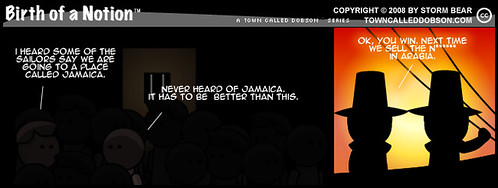 click to enlarge Subscribe to Town Called Dobson by Email! In order to achieve profit, the owners of the ships divided their hulls into holds with little headroom, so they could transport as many slaves as possible. Unhygienic conditions, dehydration, dysentery and scurvy led to a high mortality rate, up to a third of captives. Only the most resilient survived the transport. Often the ships transported hundreds of slaves, who were chained tightly to plank beds. For example, the slave ship "Henrietta Marie" carried about 200 slaves on the long Middle Passage. They were confined to cargo holds with each slave chained with little room to move. The most important routes of the slave ships led from the northern and middle coasts of Africa to South America and the south coast of what is today the Caribbean and the United States of America. The captains and sailors of the boats were allowed to do whatever they wanted with the slaves. This included rape, murder, and torture because the slaves were considered their property. As many as 20 million Africans were transported by ship. The transportation of slaves from Africa to America was known as the Middle Passage. The African slave trade was outlawed in 1807, by a law passed jointly in the United States of America and the United Kingdom, the applicable UK Act was the Abolition of the Slave Trade Act and outlawed slavery throughout the British Empire. The US law took effect on January 1, 1808. After that date all US and English slave ships leaving Africa were legally pirate vessels subject to capture by the American and British navies. It was 1815 at the Council of Vienna before Spain, Portugal, France and The Netherlands agreed to abolish their slave trade. During this time, the slave ships became smaller and more cramped in exchange for improved performance in their new role as smuggling craft and blockade runners. Only a few decades after the discovery of America by Europeans, demand for cheap labor to work plantations made slave-trading a profitable business. The peak time of slave ships to the Atlantic passage was between the 17th and 18th century when large plantations developed in the English colonies of North America. The Arab slave trade was the practice of slavery in West Asia, North Africa, East Africa, and certain parts of Europe (such as Sicily and Iberia) during their period of domination by Arab leaders. The trade mostly involved North and East Africans and Middle Eastern peoples (Arabs, Berbers, Persians, etc.). Also, the Arab slave trade was not limited to people of certain color, ethnicity, or religion. In the early days of the Islamic state—during the 8th and 9th centuries—most of the slaves were Slavic Eastern Europeans (called Saqaliba), people from surrounding Mediterranean areas, Persians, Turks, other neighbouring Middle Eastern peoples, peoples from the Caucasus Mountain regions (such as Georgia and Armenia) and parts of Central Asia (including Mamluks), Berbers, and various other peoples of varied origins as well as those of Black African origins. Later, toward the 18th and 19th centuries, slaves increasingly came from East Africa. Some historians estimate that between 11 and 18 million black African slaves crossed the Red Sea, Indian Ocean, and Sahara Desert from 650 CE to 1900 CE, or more than the 9.4 to 14 million Africans brought to the Americas in the Atlantic slave trade. The medieval slave trade in Europe was mainly to the East and South: The Byzantine Empire and the Muslim World were the destinations, pagan Central and Eastern Europe an important source. Slavery in medieval Europe was so common that the Roman Catholic Church repeatedly prohibited it— or at least the export of Christian slaves to non-Christian lands was prohibited at, for example, the Council of Koblenz in 922, the Council of London in 1102, and the Council of Armagh in 1171. Viking, Arab, Greek and Jewish merchants (known as Radhanites) were all involved in the slave trade during the Early Middle Ages. So many Slavs were enslaved that the very name 'slave' was derived from their name; not only in English, but in other European languages and Arabic as well. Periodic raiding expeditions were sent from Islamic Iberia to ravage the Christian Iberian kingdoms, bringing back booty and slaves. In a raid against Lisbon in 1189 CE, for example, the Almohad caliph Yaqub al-Mansur took 3,000 female and child captives, while his governor of Córdoba, in a subsequent attack upon Silves in 1191 CE, took 3,000 Christian slaves. According to Robert Davis between 1 million and 1.25 million Europeans were captured by Barbary pirates, who were vassals of the Ottoman Empire, and sold as slaves between the 16th and 19th centuries. This considerably exceeds the figure of 645,000 Africans who were brought to what is now the United States. These slaves were captured mainly from seaside villages from Italy, Spain, Portugal and also from more distant places like France or England, the Netherlands, Ireland and even Iceland and North America. The impact of these attacks was devastating – France, England, and Spain each lost thousands of ships, and long stretches of the Spanish and Italian coasts were almost completely abandoned by their inhabitants. Pirate raids discouraged settlement along the coast until the 19th century. The Ottoman wars in Europe and Tatar raids brought large numbers of Christian slaves into the Islamic world too. The 'Oriental' or 'Arab' slave trade is sometimes called the 'Islamic' slave trade, but a religious imperative was not the driver of the slavery, Patrick Manning, a professor of World History, states. However, since if a non-Muslim population refuses to adopt Islam or pay the Jizzya protection/ subjugation tax, that population is considered to be at war with the Muslim "ummah" and therefore it becomes legal under Islamic law to take slaves from that non-Muslim population. Usage of the terms "Islamic trade" or "Islamic world" has been disputed by some Muslims as it treats Africa as outside of Islam, or a negligible portion of the Islamic world. Propagators of Islam in Africa often revealed a cautious attitude towards proselytizing because of its effect in reducing the potential reservoir of slaves. Disclaimer:
|
Thursday, March 27, 2008
Black History: Sailing To Arabia
Subscribe to:
Post Comments (Atom)








0 comments:
Post a Comment